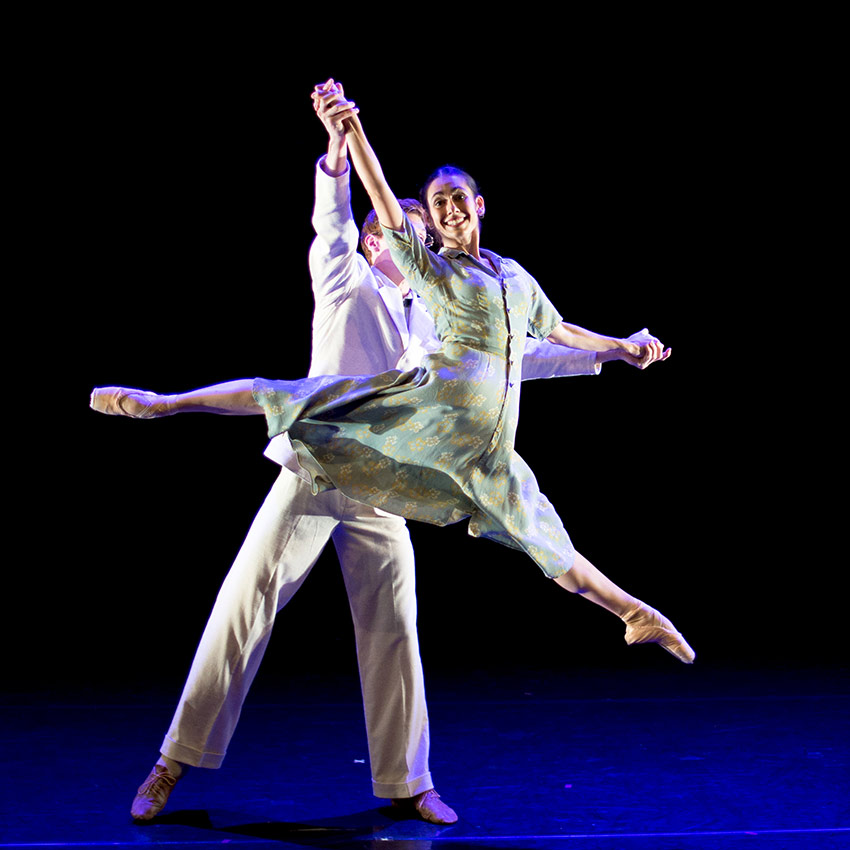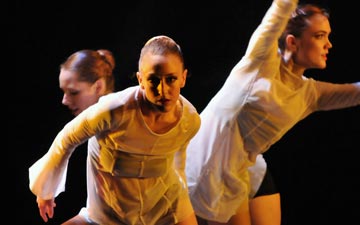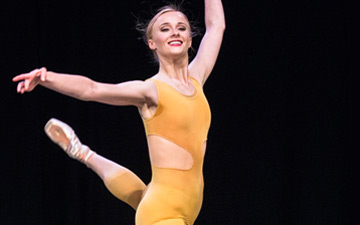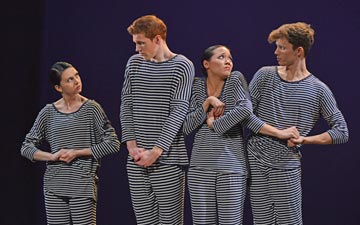
© Deborah Jaffe Photography. (Click image for larger version)
New English Ballet Theatre
New Works: Unbridled Blood, Domino, Rosamunde, All in passing, Two Husbands
★★★✰✰
London, Lilian Baylis Studio
5 September 2019
www.nebt.co.uk
www.sadlerswells.com
It is nine years since Karen Pilkington-Miksa first launched New English Ballet Theatre and with each season, there has been substantial growth in all areas of the company and productions. Her determination to bridge the gap between the end of training and professional status has helped numerous dancers and choreographers on the path to success (most notably, Isabella Gasparini in The Royal Ballet, Georgie Rose in Norwegian National Ballet and choreographer, Andrew McNicol, who created a work for Joffrey Ballet, among other things, earlier this year). Pilkington-Miksa is also intent on giving a platform to emerging musicians, composers and designers, thus promoting an entirely collaborative experience. This year’s season began with a Choreography Lab, hosted by the Royal Opera House with The Royal Ballet, which saw eight choreographers over the course of a few weeks, create pieces on dancers who were mostly unfamiliar to them. The rules were simple, they each had twelve and a half hours of rehearsal to come up with the beginnings of a creation on the premise that these early ideas will come to fruition in time for the 10th anniversary season next year.
The outcome was that four choreographers presented their short pieces as a ‘work in progress’ in a season at the Lilian Baylis. A fifth, Daniela Cardim, who is the general/company manager of NEBT, was given a longer period to rehearse her ballet, Two Husbands, and this was shown in full. In the event, the levels of polish and invention were quite remarkable given the circumstances.

© Deborah Jaffe Photography. (Click image for larger version)
Opening the evening was Érico Montes’ Unbridled Blood set to the 3rd movement of Beethoven’s Piano Sonata No.14 in C Sharp Minor, the famous ‘Moonlight’ Sonata. As a dancer with The Royal Ballet, it comes as no surprise that Montes has created a work that is lyrical, very musical and well-structured. Use of épaulement was very much in evidence – a real pleasure to watch these days and whilst it was technically difficult, the fluidity of the choreography allowed the dancers to express the music with smooth élan. In a post-performance Q & A, Montes discussed his love of the pure classical vocabulary. He explained that there is pressure to move away from the classical genre but claimed, “I will not be joining them.” This genuine respect for the art form reveals itself within the choreography, resulting in a very pleasing aesthetic.
Second up was Ruth Brill’s Domino to various pieces of music by Ryuichi Sakamoto. She too, has created something that appears very structured. Clever duets, shapes and use of the music made it very appealing. She mentioned afterwards how her career trajectory with Birmingham Royal Ballet (which she has now left to pursue work as a freelance choreographer) had felt very logical, safe and that no jump felt too big. Moving forward with NEBT, she has been working with dancers new to her, but claimed this had been rewarding, having had the freedom to experiment and play. This experience can only enhance and broaden her progress as a choreographer.
Morgann Runacre-Temple’s Rosamunde was a bold statement. More contemporary than the others, the score contributed greatly to its success. Using Schubert’s String Quartet No.13 in A minor, composer Tom Lane has written additional music that is most effective. Visually attractive this work looks set to be a keeper with the change of pace and dynamics – most engaging.
All in passing by Peter Leung, was yet another striking piece in a very different vein. Leung, a former dancer with Dutch National Ballet, has his own Netherlands based troupe, House of Makers, which has clearly given him the confidence to take risks. With a superb, commissioned score by Nicholas Robert Thayer and a lighting installation by Hendrik Walther which reflected the rhythm of the music, the choreography already has a pulse and is likely to be distinctive when completed.
All the choreographers, without exception, said the speed and success of their work was down to the commitment and talent of the dancers, citing them as being “hungry” to learn and “hugely versatile.” This must have been a great benefit. Most of them were in at least three of the four works in the first half, with rapid costume changes, and almost no pause for breath. The standard overall is extremely high but a mention should go to Daniel Corthorn, who did not appear in the second half of the evening. He is a very gifted dancer with superb ballon, moving with supreme fluidity and a certain ease that tricks the eye into missing the preparation for a jump.

© Deborah Jaffe Photography. (Click image for larger version)
After the interval, Cardim’s Two Husbands was perhaps the toughest challenge, as a narrative work and a comedy at that, yet she is an experienced and skilled choreographer. The story, based on an old Brazilian folktale, is about a young woman, Fleur (Camino Llonch), whose husband Vincent (Mario Gaglione) is what one might call these days, a narcissist. He has charm (and is loved by his wife) but he’s a liar, a cheat and a manipulator, who has to have his own way and somehow gets away with it. He gets his comeuppance when he suddenly drops dead at a carnival. After a period of mourning, Fleur is encouraged by her friend Ana (the delightful Ermelinda Giacometti) to come back into society where she meets a kind man, Theodore (Alexander Nuttall) whom she marries. He doesn’t match up to Vincent’s brazen machismo and she is haunted (literally) by the ghost of her late husband.
It is funny in places. The sight of Nuttall in his stripy pyjamas on his wedding night and the expression on his face is one not easily forgotten. Nuttall is also an elegant dancer and outstanding partner. There is a scene on a bus that is amusing and there are some lyrical passages of choreography in the solos and pas de deux. However, the ballet could be improved by re-examining the depth of the characters. The length of the piece (about half an hour) means that there is simply no time to develop the individuals. A lifetime of important events happens at breakneck speed. Vincent (well danced and acted by Gaglione) dies within the first minutes of the ballet. It’s difficult to empathise with a character who is clearly a bit of a pain in the backside. And Fleur, so sweetly danced by Llonch, needs to get a grip. Her wily ex is actually desperately selfish. In order to believe in the essence of the story, the characters need to be more believable.
Where Cardim has succeeded is that the story is clear – there is no need to read the programme beforehand and that is a feat in itself. It is a courageous step into narrative dance for her (her previous works have been abstract) and she candidly admits to the challenges she faced during the creative process. With a little more time, this ballet can be tightened up and revisited with a positive outcome. New English Ballet Theatre is a small scale company that is packed with burgeoning talent, diverse offerings and plenty of pluck.

















You must be logged in to post a comment.